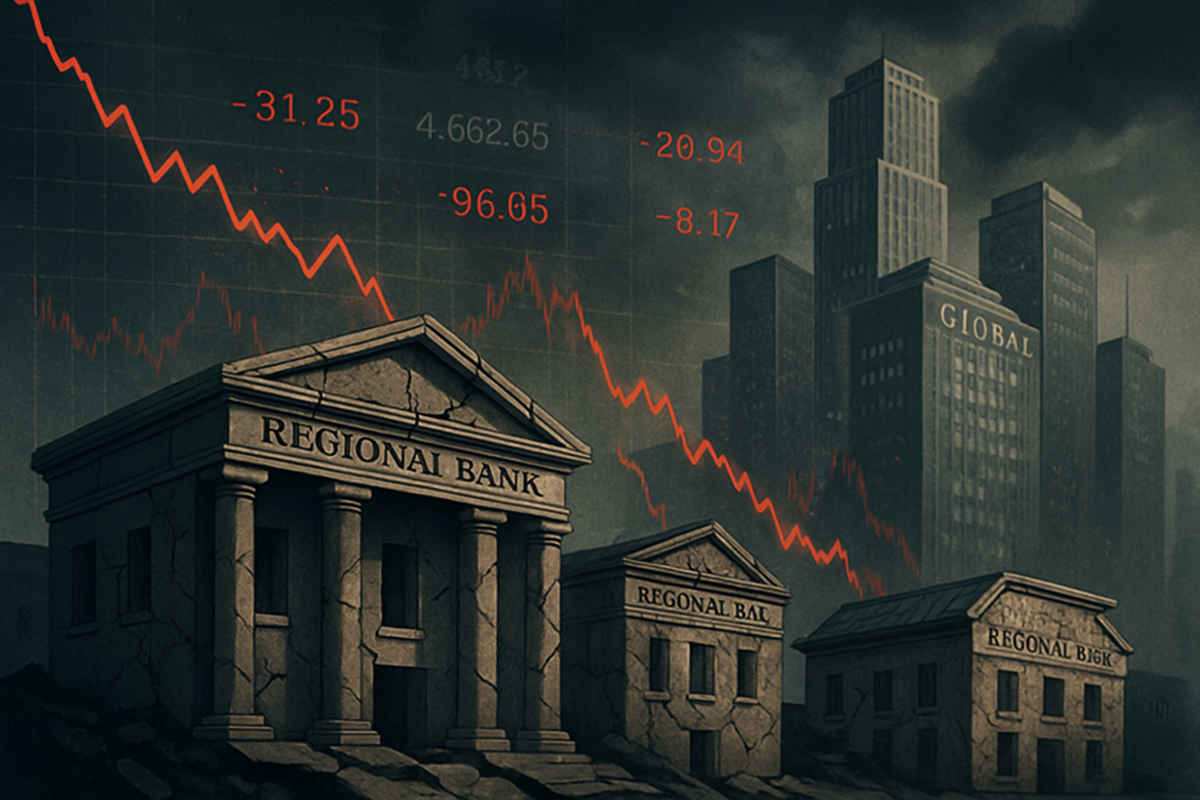Financial News
Global Banking Sector Grapples with Mounting Credit Quality Concerns as Regional Banks Reveal Troubling Loan Losses

The global banking sector is facing increasing scrutiny as regional banks, particularly in the U.S., disclose a wave of bad loans and significant loan loss provisions. This trend, largely driven by substantial exposure to the commercial real estate (CRE) market and exacerbated by elevated interest rates, has triggered immediate market volatility and a discernible flight to safety among investors. These revelations, coming to light leading up to October 16, 2025, are forcing a reevaluation of credit risk across the financial landscape.
The immediate fallout includes sharp declines in the stock prices of affected regional lenders, increased pressure on profitability due to higher loan loss provisions, and a likely tightening of credit standards, especially for CRE lending. While larger, global systemically important banks (GSIBs) appear more resilient, the disclosures have reignited concerns about potential systemic fragilities and hidden risks within the broader banking system, prompting a cautious outlook for the financial market as a whole.
Unpacking the Credit Contagion: Fraud, CRE, and Market Jitters
The recent surge in credit quality concerns stems from a confluence of factors, with specific disclosures from regional banks acting as immediate catalysts. On October 16, 2025, Zions Bancorporation (NASDAQ: ZION) sent tremors through the market by announcing a $50 million charge-off related to two commercial and industrial loans within its California Bank & Trust division. The bank cited "apparent misrepresentations and contractual defaults" and "other irregularities" by the borrowers, indicating potential fraud. Zions further projected a $60 million provision for credit losses for its upcoming third-quarter results, signaling a preemptive move to absorb anticipated defaults. Simultaneously, Western Alliance Bancorporation (NYSE: WAL) saw its shares tumble after disclosing a lawsuit against a borrower for alleged fraud, specifically the failure to provide collateral loans in a first-position lien. These incidents, while potentially isolated in their specifics, have amplified broader anxieties about underlying credit quality.
A more systemic and pervasive issue driving these concerns is the regional banking sector's outsized exposure to Commercial Real Estate (CRE). Regional banks hold approximately 44% of their total loan portfolios in CRE, a stark contrast to the 13% held by larger, diversified institutions. This concentration has become a significant vulnerability, particularly as a "maturity wall" of over $1 trillion in CRE loans is set to mature by the end of 2025. These loans, often originated in a lower interest rate environment, now face immense refinancing hurdles amidst elevated interest rates and declining property valuations, especially in the struggling office sector. Delinquency rates for U.S. office loans are nearing 10.4% as of October 2025, a level approaching the 2008 peak and representing the fastest spike in history. Beyond CRE, other pockets of distress have emerged; JPMorgan Chase & Co. (NYSE: JPM) recently reported a $170 million charge-off linked to the collapse of subprime auto lender Tricolor Holdings, and Fifth Third Bancorp (NASDAQ: FITB) disclosed a potential $200 million loan loss tied to suspected fraud, illustrating that credit quality issues are not solely confined to real estate.
The timeline leading up to this moment reveals a gradual but accelerating deterioration. The Federal Reserve's aggressive interest rate hikes, commencing in 2022, set the stage by increasing borrowing costs and pressuring highly leveraged sectors. The banking turmoil of 2023, including the failures of Silicon Valley Bank and Signature Bank, first highlighted systemic fragilities, with CRE exposure emerging as a persistent concern. Throughout late 2023 and Q4 2024, CRE loan delinquency rates steadily climbed. By Q1 2025, Zions Bancorporation (NASDAQ: ZION) reported an increase in criticized loans, with CRE loans showing particular vulnerability. The recent disclosures on October 16, 2025, acted as a tipping point, triggering a broad market sell-off in regional bank stocks. Key stakeholders involved range from affected regional banks like Zions Bancorporation (NASDAQ: ZION), Western Alliance Bancorporation (NYSE: WAL), and Jefferies Financial Group (NYSE: JEF), to larger institutions like JPMorgan Chase & Co. (NYSE: JPM) which, while more resilient, are not entirely immune. Regulators such as the Federal Reserve and the FDIC are closely monitoring the situation, while investors are increasingly wary, initiating a flight to safety.
The initial market reaction was immediate and pronounced. On October 16, 2025, Zions Bancorporation (NASDAQ: ZION) shares plummeted between 11% and 13%, while Western Alliance Bancorporation (NYSE: WAL) saw an 10% to 12% drop. Jefferies Financial Group (NYSE: JEF), which had disclosed exposure to the bankrupt auto parts supplier First Brands, slid 10% on the day, contributing to a 25% decline over the past month. This triggered a sector-wide rout, with the KBW Nasdaq Regional Banking Index (KRX) sinking by 6.8% and the SPDR S&P Regional Banking ETF (NYSEARCA: KRE) falling between 4.6% and 6.5%. The sell-off spilled into the broader market, with the S&P 500 and Dow Jones Industrial Average registering declines. A clear "flight to safety" was evident, as 10-year Treasury yields fell below 4%, and gold climbed to a new record high, surpassing $4300 per ounce. JPMorgan Chase CEO Jamie Dimon's earlier warning that "when you see one cockroach, there are probably more" resonated deeply, intensifying market fears of hidden credit problems and signaling a renewed period of volatility and scrutiny for regional lenders.
Companies Poised to Win or Lose in a Shifting Credit Landscape
The escalating credit quality concerns, particularly from regional bank bad loans and CRE exposure, are creating a challenging environment that clearly delineates potential winners and losers among public financial institutions. Regional banks, with their concentrated exposure to vulnerable sectors, face significant headwinds, while larger, more diversified institutions are demonstrating greater resilience and even identifying strategic opportunities.
Companies Poised to Lose:
Regional banks, especially those with high concentrations of Commercial Real Estate (CRE) loans and smaller, less diversified balance sheets, are squarely in the "losing" column. These institutions are directly impacted by rising loan loss provisions, diminished profitability, and increased investor scrutiny.
- Zions Bancorporation (NASDAQ: ZION) saw its shares plunge by as much as 13% on October 16, 2025, after disclosing a $50 million charge-off and a projected $60 million provision for credit losses. Its stock performance has been directly hit by these revelations, and its business operations will be pressured by reduced profitability and tighter lending standards, particularly for CRE. The strategic outlook for Zions will likely involve intensive risk mitigation, balance sheet deleveraging, and efforts to reduce CRE exposure to rebuild investor confidence.
- Western Alliance Bancorporation (NYSE: WAL) also experienced an 11% stock drop on October 16, 2025, following its disclosure of a lawsuit against a fraudulent borrower. Similar to Zions, its stock has been significantly impacted, and its operations will face heightened scrutiny of loan portfolios and increased vigilance against fraud. The bank's strategy will likely prioritize strengthening internal controls and carefully assessing new lending opportunities.
- Other regional banks with notable CRE exposure, such as Flagstar Financial (part of New York Community Bancorp (NYSE: NYCB)), Banc of California Inc. (NYSE: BANC), Webster Financial (NYSE: WBS), Metropolitan Bank Holding (NYSE: MCB), Axos Financial (NYSE: AX), and Bank OZK (NASDAQ: OZK), are also vulnerable. These banks are likely to experience continued volatility and downward pressure on their stock prices as credit quality concerns persist. Their business operations will be strained by increased loan loss provisions and potential liquidity constraints. Strategically, many will focus on de-risking balance sheets and diversifying revenue streams, with some smaller institutions potentially facing distress or even acquisition. The SPDR S&P Regional Banking ETF (NYSEARCA: KRE) itself suffered a 6.1% drop on October 16, 2025, reflecting the broad investor unease across the sector.
Companies Poised to Win (or Demonstrate Resilience):
In contrast, larger, globally diversified financial institutions, often classified as Global Systemically Important Banks (GSIBs), are generally better positioned to navigate these turbulent waters. Their diversified revenue streams, stronger capital bases, and lower relative exposure to problematic sectors provide a significant buffer.
- JPMorgan Chase & Co. (NYSE: JPM) has demonstrated resilience, reporting strong earnings driven by its diversified business model, including robust investment banking and trading revenues. While not entirely immune (as evidenced by its $170 million charge-off from Tricolor Holdings), its strong capital base and proactive risk management, including advising investors to avoid CRE debt, position it favorably. JPMorgan's strategic outlook includes conservative risk management and potential benefits from market consolidation, as struggling regional banks may present acquisition opportunities.
- Citigroup Inc. (NYSE: C) and Bank of America (NYSE: BAC) have also reported solid earnings, supported by diversified portfolios and robust balance sheets. Both have proactively increased credit reserves, anticipating macroeconomic deterioration. Their broad global operations and strong consumer banking segments provide stability against regional downturns. Their strategies will focus on leveraging diversified income streams and proactive asset resolution.
- Wells Fargo & Company (NYSE: WFC), despite some CRE-related charge-offs, has been actively shrinking its commercial property portfolios and noting improvements in its CRE office portfolio. Its strategic de-risking of CRE exposure positions it for greater resilience.
- Investment banks like Morgan Stanley (NYSE: MS) and Goldman Sachs (NYSE: GS) are also well-positioned. Their revenue streams are less directly tied to traditional regional bank loan books and more to capital markets activity, which has shown strength. They benefit from increased deal-making and trading volumes, potentially gaining market share and talent during periods of distress in the commercial banking sector.
In summary, while regional banks face significant challenges to their profitability and operational stability, larger, diversified banks with robust capital and strong non-interest income streams are demonstrating greater resilience and may even find opportunities for strategic growth through market consolidation in this evolving credit landscape.
Wider Significance – A Looming Shadow Over the Financial System
The escalating credit quality concerns, particularly those emanating from regional banks and the Commercial Real Estate (CRE) sector, represent far more than isolated incidents; they signify a potentially critical inflection point for the broader financial system. As of October 2025, these issues are intertwining with significant industry trends, posing ripple effects across competitors and partners, prompting regulatory responses, and drawing unsettling parallels to historical financial crises.
Broader Industry Trends and Ripple Effects: The most pronounced trend is the disproportionate exposure of regional banks to CRE debt, which constitutes approximately 44% of their total loan portfolios. This concentration, coupled with elevated interest rates and declining property values (especially in the office sector, where delinquency rates are nearing 2008 peaks at 10.4%), creates a precarious situation. The "maturity wall" of over $1 trillion in CRE loans due by the end of 2025 presents a formidable refinancing challenge, potentially forcing banks into "extend and pretend" scenarios that merely delay loss recognition. This situation is likely to lead to tighter lending standards across the board, potentially creating a "credit crunch" that hampers economic activity for businesses and consumers alike. Furthermore, the increasing prominence of non-bank financial institutions (NBFIs), or "shadow banking," is a growing concern. These less regulated entities are stepping in to fill the financing gap, but their opaque nature and increasing interconnectedness with traditional banks (with some banks having nonbank exposures exceeding their Tier 1 capital) mean that stress in this sector could quickly transmit to the core banking system, amplifying systemic risks. The struggles of smaller regional institutions could also accelerate market consolidation, providing larger, well-capitalized banks like JPMorgan Chase & Co. (NYSE: JPM) opportunities to acquire assets or portfolios at favorable terms.
Regulatory and Policy Implications: In response to these mounting concerns, regulatory bodies are intensifying their focus on risk management and oversight. There's a clear emphasis on enhanced stress testing, including the Federal Reserve's 2025 stress tests, to assess resilience against severe declines in CRE values. The ongoing implementation of tougher final Basel III requirements also aims to bolster capital and liquidity. Regulators are increasing scrutiny of NBFIs, acknowledging their growing systemic importance and the need for greater transparency and oversight to mitigate potential contagion. The FDIC has introduced new reporting requirements for loan modifications to financially distressed borrowers, signaling a push for greater disclosure. Policymakers are also being urged to strengthen internal controls and governance within banks, and macroprudential tools are being considered to "lean against the wind" of rising debt. However, a fragmented global regulatory landscape, exacerbated by geopolitical shifts, could complicate efforts for international financial firms.
Historical Precedents and Comparisons: The current credit quality concerns evoke unsettling memories of past financial crises. The prominence of bad office loans and substantial CRE debt maturities today draws parallels to the role of subprime home loans in the lead-up to the 2008 global financial crisis. Historically, rapid credit growth and periods of market euphoria, followed by sharp increases in interest rates, have often preceded banking crises. The "higher-for-longer" interest rate environment currently stresses weaker borrowers, reminiscent of how previous rate hikes exposed vulnerabilities. The failures of Silicon Valley Bank and Signature Bank in 2023 served as a stark reminder of the importance of robust capital and liquidity, a lesson learned from 2008. While banks have since shortened the maturity of their securities portfolios, the fundamental challenge of asset-liability mismatches and credit deterioration persists. A potential "deleveraging" process, where firms and households repay debt and banks become reluctant to lend, could lead to a "credit crunch" that stifles economic activity, echoing the aftermath of previous downturns. The recurring pattern of banking crises often results in sector consolidation, with larger, more stable banks increasing their market share, a trend that is likely to continue if regional bank distress intensifies.
The broader significance of these escalating credit quality concerns is a stark reminder of the interconnectedness of the financial system and the potential for localized issues to cascade into systemic risks. Regulators and market participants are navigating a complex landscape, striving to prevent widespread contagion while adapting to evolving financial structures and historical lessons.
What Comes Next – Navigating a Shifting Financial Landscape
The current credit quality concerns, particularly within the regional banking sector and the Commercial Real Estate (CRE) market, set the stage for a dynamic period ahead for the global financial industry. Both short-term pressures and long-term strategic shifts will define the trajectory of banks and the broader economy.
Short-Term and Long-Term Possibilities: In the short term (next 6-12 months), the banking sector is bracing for elevated credit losses, primarily driven by the ongoing distress in CRE. The "maturity wall" of commercial mortgages due in 2025, coupled with high interest rates and declining property values, is expected to lead to a wave of defaults. Regional banks, with their concentrated CRE exposure, will likely continue to face increased loan loss provisions and pressure on profitability. However, some analysts anticipate a potential rebound in loan activity and an acceleration of mergers and acquisitions (M&A), partly spurred by the Federal Reserve's recent interest rate cuts (which began in September 2025). Larger, diversified banks like JPMorgan Chase & Co. (NYSE: JPM) are expected to demonstrate continued resilience, benefiting from robust interest income and healthy non-interest revenues.
Looking further ahead (1-5 years), the long-term outlook suggests a normalization of the credit cycle, though with potentially manageable loan losses due to improved risk management practices adopted post-2008. Consolidation through M&A is expected to accelerate, as smaller, struggling regional banks become targets for larger, more stable institutions. Continuous investment in AI and digital transformation will be crucial for operational efficiency and enhanced customer experience. Banks will also need to maintain strategic pivots towards diversified revenue streams, particularly expanding wealth management and advisory services, and integrating Environmental, Social, and Governance (ESG) principles into their growth strategies. Challenges will persist, however, including subpar economic growth, ongoing geopolitical shocks, and regulatory uncertainty, demanding adaptability to a potentially lower-rate, lower-growth environment.
Potential Strategic Pivots and Adaptations: Banks are already initiating several strategic pivots to navigate this challenging environment. Proactive risk management is paramount, involving enhanced early warning systems for CRE and consumer lending, and a concerted effort to diversify loan portfolios away from highly concentrated sectors. Many banks are increasing loan loss reserves in anticipation of future credit deterioration. Diversification of revenue streams, with a greater focus on non-interest income from investment banking, wealth management, and advisory services, is a key strategy to reduce reliance on volatile interest rate cycles. Significant investment in technology and digital transformation is crucial for operational efficiencies, robust fraud detection, and hyper-personalization for customers. Cost optimization remains a priority to counteract high deposit costs. For regional banks, strategic M&A and partnerships with fintech firms may offer pathways to achieve greater scale and resilience. Across the board, tighter underwriting standards, focusing on existing customers and deals with strong fundamentals, will become the norm, especially in CRE.
Market Opportunities and Challenges: The current distress presents both significant challenges and unique opportunities. For distressed asset investors and private credit funds, the turmoil in the CRE market offers a chance to acquire properties or non-performing loans from struggling banks at a discount, filling the financing gap left by traditional lenders. This shift, however, also moves systemic risk into the less regulated "shadow banking" sector, posing a long-term challenge for financial stability. Emerging markets, conversely, could present opportunities. In 2025, some are seeing a resurgence of investor interest due to strong growth, attractive real yields, and expectations of lower U.S. interest rates. By 2035, these countries are projected to drive roughly 65% of global economic growth. However, challenges persist, including trade tariffs, geopolitical fragmentation, slowing exports from China, and the potential for sudden market corrections.
Potential Scenarios and Outcomes: Several scenarios could unfold. A "gradual stabilization and consolidation" scenario envisions a period of deleveraging leading to a more resilient, albeit smaller, number of regional players, with larger, diversified banks continuing to perform well. Conversely, "prolonged underperformance and distress" could materialize if credit quality continues to deteriorate, potentially leading to further bank failures, especially given that a 10% loss on maturing CRE loans could render 100 banks undercapitalized. Another outcome could be a "front-end revolution," where non-bank players increasingly capture customer relationships, while traditional institutions handle background processing, highlighting the growing influence of fintechs and private credit markets. Despite these uncertainties, the industry has shown resilience, with sector profitability generally remaining in double digits globally. Ultimately, strategic adaptability, robust risk management, technological adoption, and revenue diversification will be crucial for banks to navigate these evolving credit quality concerns and capitalize on emerging opportunities.
Comprehensive Wrap-Up: Navigating the Credit Crossroads
The global banking sector, as of October 16, 2025, finds itself at a critical juncture, grappling with escalating credit quality concerns that are particularly acute within regional banks and the Commercial Real Estate (CRE) market. This period of heightened vigilance is not merely a transient phase but a reflection of deeper structural shifts and economic pressures that will shape the financial landscape for years to come.
Summary of Key Takeaways:
The core of the current unease stems from several interconnected factors. Regional banks, especially in the U.S., are under immense pressure due to their concentrated exposure to vulnerable sectors. Recent disclosures from Zions Bancorporation (NASDAQ: ZION) and Western Alliance Bancorporation (NYSE: WAL) regarding significant loan charge-offs and alleged fraud have severely impacted investor confidence, leading to sharp declines in their stock values and broader market jitters. The Commercial Real Estate (CRE) sector stands out as a major vulnerability, with regional banks holding a disproportionate 44% of their total loans in CRE debt. Office properties, in particular, are struggling with declining valuations and reduced demand, pushing delinquency rates for U.S. office loans to 10.4%—a level nearing 2008 peaks. The looming "maturity wall" of over $1 trillion in CRE loans set to mature by the end of 2025 presents substantial refinancing challenges. Furthermore, the persistent "higher-for-longer" interest rate environment continues to exert pressure on borrowers and contributes to increasing charge-offs for banks, leading to tighter lending standards. Adding another layer of complexity are the emerging risks from the "shadow banking" sector, or non-bank financial institutions (NBFIs), and private credit. These less-regulated entities are increasingly underpinning financing, and recent bankruptcies of companies backed by private credit have highlighted potential systemic cracks and opaque risks, prompting warnings from figures like JPMorgan CEO Jamie Dimon. While regional banks face significant headwinds, larger, diversified global banks, such as JPMorgan Chase & Co. (NYSE: JPM), appear better positioned due to stronger capital buffers and diversified portfolios.
Assessment of the Market Moving Forward:
The market is expected to endure continued volatility, particularly within the regional banking sector. Elevated credit losses are anticipated in the short term (next 6-12 months), primarily driven by ongoing distress in the CRE sector. The significant volume of commercial mortgages maturing in 2025, originated in a more favorable interest rate environment, makes refinancing difficult, potentially leading to a wave of defaults. Consumer loan delinquencies are also expected to rise modestly.
However, the outlook for global banks, as of mid-2025, generally remains stable with broad ratings stability anticipated for 2025-2026. Analysts project a rise in global banks' credit losses by over US$140 billion over the two years to end-2026, reaching around US$750 billion in 2025 and over US$800 billion in 2026. While lower interest rates are expected to put pressure on Net Interest Income (NII), they should eventually boost asset quality and loan demand, with loan growth projected to pick up globally by 6% in 2025. Some banks are even eyeing a potential return to increased CRE lending in 2025 as interest rates fall. Regulatory bodies are tightening lending standards and focusing on risk management, though calls for simplification of regulation in the U.S. could limit supervisory effectiveness. Geopolitical uncertainties, trade tensions, and the evolution of new technologies like AI also pose downside risks.
Final Thoughts on Significance and Lasting Impact:
The current credit quality concerns, particularly those emanating from regional banks and CRE, represent a critical test for the resilience of individual financial institutions and the broader financial system. The lasting impact could include further consolidation within the regional banking sector as smaller institutions grapple with concentrated exposures and the need for greater scale and diversification. The growing prominence of less-regulated private credit markets also poses a systemic risk that regulators and investors are increasingly mindful of, reminiscent of triggers for past financial crises. The situation underscores the importance of robust risk management and diversified portfolios in a changing economic landscape.
What Investors Should Watch For in Coming Months:
Investors should remain highly vigilant and monitor several key indicators:
- Regional Bank Performance: Keep a close eye on the earnings reports and loan loss provisions of regional banks, especially those with significant CRE exposure. Further disclosures of bad loans or fraud could trigger additional market volatility. The SPDR S&P Regional Banking ETF (NYSEARCA: KRE) serves as a good benchmark.
- Commercial Real Estate Market: Pay attention to CRE delinquency rates, particularly for office properties, and the success (or failure) of refinancing efforts for the large volume of CRE loans maturing in 2025. Property valuations and demand trends in key urban centers will be crucial.
- Interest Rate Trajectory: While the Federal Reserve has recently cut rates and is expected to continue easing, the pace and extent of these cuts will influence bank profitability and borrowers' ability to service debt. However, even with anticipated cuts, deposit costs are expected to remain elevated, pressuring net interest margins.
- Private Credit Market Developments: Watch for any further signs of stress or failures in the "shadow banking" sector, as these could have ripple effects across the broader financial system and CRE finance.
- Regulatory Actions: Monitor regulatory responses and potential policy changes, especially concerning lending standards and oversight of non-bank financial institutions.
- Consumer Credit Quality: Keep an eye on delinquency rates for consumer loans, particularly credit cards and auto loans, as household finances come under pressure.
The current period calls for a cautious approach, with a focus on banks demonstrating strong capital buffers, diversified revenue streams, and robust risk management practices.
This content is intended for informational purposes only and is not financial advice
More News
View More




Recent Quotes
View More
Quotes delayed at least 20 minutes.
By accessing this page, you agree to the Privacy Policy and Terms Of Service.



